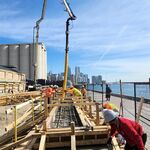Found this video on youtube. It puts into perspective how North York Centre was built, but it doesn't answer the question of why Sheppard hasn't developed. Thoughts?
First of all, that video looks at it from an outsider's perspective "looking at just the map",... it doesn't realize there's a North York Centre Secondary Plan with service roads of Beecroft & Doris as the boundary between high-density development & protecting existing single-residential houses.
Now just like the video,... let's look at the map! Even before all the development,... As you can see, a road-grid system dominated by east-west side streets,... meaning majority of folks leave their house and walk east-west on their east-west streets towards Yonge Street,... where they'll go north-south to subway. Yonge Street get foot-traffic,... so that's where coffee, food, retailers set up shop and succeed! Thus, Yonge Street becomes lively commercial strip,... On most parts of Sheppard, good luck finding someone walking on Sheppard!
Anyways, Yonge Corridor VS Sheppard Corridor,.... when Yonge Subway was extended to Sheppard & Finch Stations in 1974, City of North York was already had a solid plan to build a Downtown along Yonge St corridor (bonded by service roads of Beecroft & Doris) from 401 to Finch Hydro Corridor. Office tower only on Yonge St, residential tower off Yonge frontage towards Beecroft & Doris,... Yonge-Sheppard Centre with 2 office tower on Yonge, 3 apartment tower off Yonge towards Doris & mall podium was built to this framework & completed in 1976. Mayor Mel Lastman was a true salesman and convinced major corporations (Nestle Canada, Proctor & Gamble, Warner Brothers, Xerox, North American Life Insurance, Federal & Provincial government offices, etc,...) to set up head-offices in Downtown North York,... even built Underground PATH system to compete against downtown Toronto.
Mel Lastman promoted and got Sheppard Subway Line built, but PC Premier Mike Harris got it chopped from Scarborough Town Centre to Don Mills,... by the time the Sheppard STUBway line finally opened in 2001, the City of North York already amalgamated with Toronto & thus, there was Noooo-body to promote North York nor commercial office development along Sheppard! Sheppard STUBway line is really a case where passenger volume never justified a Subway,... only LRT.
Development within these parts of Toronto is constricted by what's allowed in Secondary Plans, North York Centre Secondary Plan area (Yonge corridor) generally allows 100m (30-storey) & 4.5FSI density, whereas Sheppard Avenue Commercial Area Secondary Plan is generally 5-6-storey & 1.5FSI density.
Massive re-development doesn't guarantee an area becomes walkable - Maclean-Hunter land got redeveloped to Avondale condos (now 14 condo tower & numerous townhouses east of Yonge between 401 & Avondale),... many of these residents walk to Sheppard Subway Station but sidewalk on east-side of Yonge between Avondale & Glendora is way too narrow (in winter reduced to single file one way only due to snow),.... alternative Bales Ave has no sidewalk on either side - only recently with Flo-Condo it got sidewalk on part of east side but rest is just asphalt.




